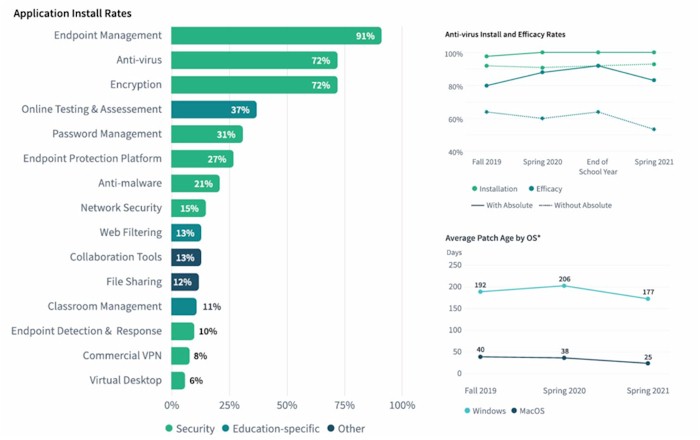Educational targets hit by rising cyberattacks in 2021
feedproxy.google.com – 2021-10-01 02:40:00 – Source link
The Transform Technology Summits start October 13th with Low-Code/No Code: Enabling Enterprise Agility. Register now!
Educational institutions are on pace for a record year of ransomware attacks in 2021, with K-12 schools the primary targets. While contributing to better educational outcomes, successful one-device-per-student and learn-from-anywhere programs have expanded the attack surface for cyber threats of various kinds.
Bad actors prioritize elementary schools because they’re underfunded when it comes to cybersecurity staff and systems, and administrators are often impatient to put attacks behind them and resume classes.
According to Sophos’ “The State of Ransomware in Education 2021,” the typical educational institution pays an average $112,435 ransom payment to get data back and networks running again. In addition, bad actors encrypt the personal identities and financial data of students, parents, and administrators as part of ransomware attacks, at times threatening to publicly release such data to further pressure victims into paying the ransom.
Crucial information on the cyber threats to education also comes via an Absolute Software “21/22 Endpoint Risk Report: Education Edition” that found the total number of devices deployed across K-12 environments increased 74% from 2019 to 2020.
Absolute’s research is noteworthy because it quantifies how the disruption caused by digital learning, including new technology adoption, opened new attack vectors for bad actors and cybercriminals.
Another fascinating aspect of the study is how school districts’ IT and cybersecurity teams are being pulled in multiple directions as they strive to secure the identities of their students, teachers, and administrators. Digital learning needs self-healing endpoints to scale globally, and protecting edge-based endpoints is just the first step.
Secure endpoints save school networks
The Absolute study makes it clear that one-device-per-student strategies are a challenge for IT teams.
Federal, state, and local government funding of learn-from-anywhere programs has worked, according to school district CIOs VentureBeat spoke with. Funds were immediately allocated to at-risk children who didn’t have internet access or devices at home to stay connected with their schools.
In many cases, Google Chromebooks have dominated new device adoption. CIOs told VentureBeat the ability to lock down selective Chromebooks that are at-risk endpoints is a must-have feature as their online student populations grow.
Meanwhile, devices of all kinds can challenge administrators, especially if the devices are overloaded with applications. Overloading endpoints with too much software makes them less secure.
A typical school’s endpoint device has 5.4 security controls per device — including VPN, antivirus, and anti?malware — compared to 11.7 security apps per device on a typical corporate endpoint device. School and enterprise endpoint devices are already crowded with software client conflicts and decay that leave endpoints vulnerable. Conflicting endpoints make IT management and audits particularly challenging.
Beyond antivirus apps
Every new app deployed on an endpoint device increases the chance of it falling victim to cyber threats. In short, endpoints continue to be weakened by too many conflicting software agents, ineffective antivirus applications, and OS patches that are long out of date.
Absolute’s study found that just 53% of antivirus applications are working effectively today and almost one-third of educational devices studied contained sensitive data. Nearly 50% house social security data, and 39% contain protected health information.

Above: Despite high endpoint management installation rates in education settings, devices continue to fall prey to bad actors’ cyber attacks. Source: Absolute Software.
Image Credit: Absolute
Absolute’s report shows the success of learn-from-anywhere strategies and other initiatives that dominate learning institutions’ IT and cybersecurity spending hinges on achieving complete visibility and control over all student and staff devices. Absolute’s study quantifies just how geographically distributed distance learning is and how endpoint devices are especially vulnerable when off a school network.
Truly self-healing endpoints are the solution to this challenge. The most reliable, scalable, and persistent self-healing endpoints deliver continuous visibility, control, and intelligence across devices, data, and applications.
Absolute’s approach of being embedded in the firmware of over half a billion Windows devices and extendable to Chrome OS and iOS has proven itself across educational institutions globally.
“In this new digital reality, the endpoint is now the edge and the primary attack surface for cybercriminals is actually in the hands of students and staff,” Absolute Software president and CEO Christy Wyatt told VentureBeat. “The ability to see, manage, and protect every endpoint device — as well as the data and applications on those devices — is critical in ensuring students and staff remain safe, connected, and productive no matter where physical learning is taking place,” she continued.
Absolute’s study accurately captures the complexity and urgency of IT and cybersecurity teams’ challenges in ensuring learn-from-anywhere initiatives can continue to serve students, teachers, and administrators. In addition, CIOs at school districts VentureBeat spoke with say Unified Endpoint Management platforms need to deliver on the promise of greater visibility and control because IT teams will have to provide audits as part of next year’s budgeting process.
VentureBeat
VentureBeat’s mission is to be a digital town square for technical decision-makers to gain knowledge about transformative technology and transact.
Our site delivers essential information on data technologies and strategies to guide you as you lead your organizations. We invite you to become a member of our community, to access:
- up-to-date information on the subjects of interest to you
- our newsletters
- gated thought-leader content and discounted access to our prized events, such as Transform 2021: Learn More
- networking features, and more
Become a member





